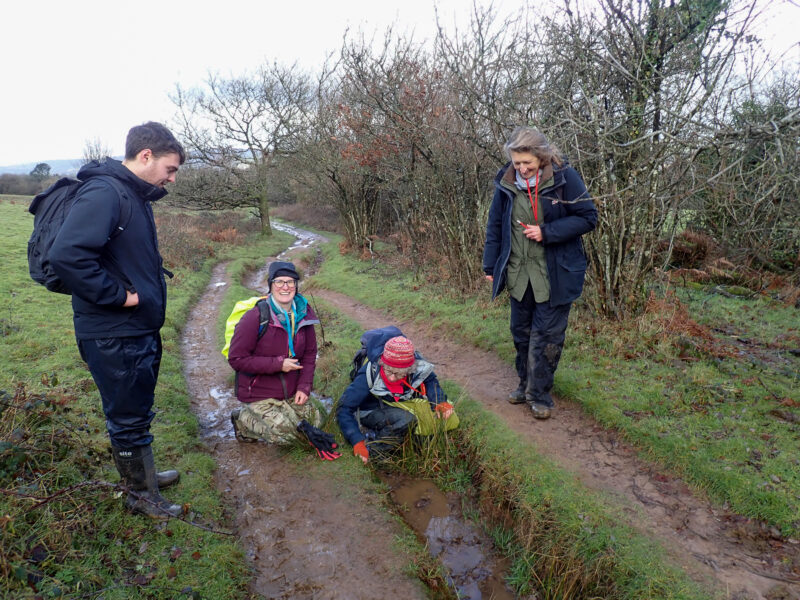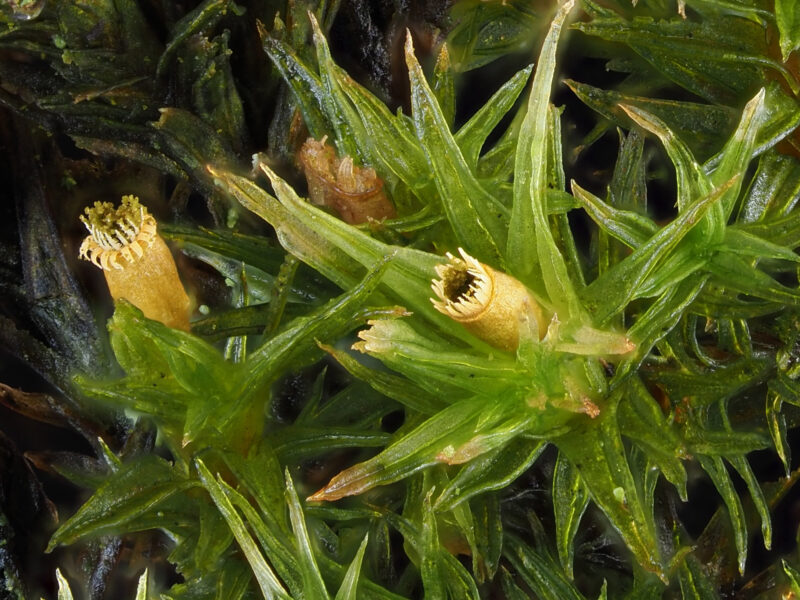Black Down is a hill in the northern Mendips which looms above the dramatic gash of Burrington Combe. Beacon Batch, at 325 metres AOD, is the highest Mendip ‘peak’ and it comprises Devonian sandstone of the Portishead Formation. The acid soils overlying the sandstone support heath and flush communities that contrast greatly with the Carboniferous limestone woods and grassland of much of Mendip.
Eight of us met in a chill wind to explore the eastern parts of Beacon Hill, from the top of Burrington Combe. The hill and its associated streams have been explored previously, and interesting species have been found. The first of these – Antitrichia curtipendula – was seen recently on a sprawling hazel not far from the road, but there has been a lot of tree and shrub clearance in the area and it could not be refound.
As we climbed the bridleway, we crossed the limestone-sandstone geological interface and found calcicoles such as Thamnobryum alopecurum juxtaposed with a few calcifuges such as Dichodontium pellucidum, which was interesting.
Walking up into the grassland and bracken of Beacon Batch, the ground was a quagmire after weeks of seemingly continuous rain. Along the way we paused to look at epiphytes on trees and found Metzgeria violacea, Plenogemma phyllantha, Cryphaea heteromalla, Orthotrichum pulchellum and a fruiting cushion of Lewinskya striata, which is almost common in Somerset these days.
A deeply rutted clay track following the eastern boundary wall was interesting, although we had to get wet knees to appreciate its bryophytes. Pogonatum aloides with capsules was abundant and it was pleasing to find the bulbiferous shoots of Pohlia annotina. This is a very common moss in many areas, but not in north Somerset and our find is only the fourth recent record in the vice-county.
Walking further south along the same track, we were becoming concerned by the sound of loud and persistent shooting, which fortunately turned out to be clay pigeon shooters on private adjacent land. Apart from making a mess in the wood where they were shooting, no animals or bryologists were harmed!
A long, moss-covered tumbledown stone wall beckoned but it was pretty overgrown by bramble and scrub and quite disappointing. It was built of mixed limestone and sandstone rocks; Homalothecium sericeum covered the former, whilst Hypnum cupressiforme was abundant on the latter. Often, Mendip walls support interesting bryophytes, such as Plasteurhynchium striatulum (always limestone), or Racomitrium lanuginosum and Ptychomitrium polyphyllum (always sandstone). This one had none of those, but it did have some patches of a robust, branched Polytrichastrum with recurved stem leaves. This reminded Sharon of P. alpinum and this is what it turned out to be. P. alpinum was found new to north Somerset on a similar-looking wall about 8 km away in 2022, so it was very pleasing to find a second population.
Higher up the hill, there are extensive fields of tussocky Purple moor-grass Molinia caerulea. These follow seepage lines and flushed ground in places but are mostly bryologically dull. Nicky, one of our newer members, was keen to get to grips with some Sphagnum, so we fanned out and quickly found some. The features of S. auriculatum, S. palustre and S. subnitens were discussed, but there wasn’t very much else to see. We had hoped to reach some potentially wetter flushes further round the hill but the going got too rough and we turned back down a track towards a farm. Crumbling concrete fence-posts sported a classic community of calcicoles with large patches of Schistidium crassipilum, Bryum capillare, Orthotrichum anomalum and Tortula muralis. Eventually we dropped down to the limestone again, and paused to admire cascades of Porella platyphylla and Neckera complanata.
Although the mud was tedious, this first meeting of 2023 gave us plenty of exercise, some fine views of Chew Valley Lake and the Bristol Channel and the chance to talk bryophytes non-stop once more.
Sharon Pilkington






